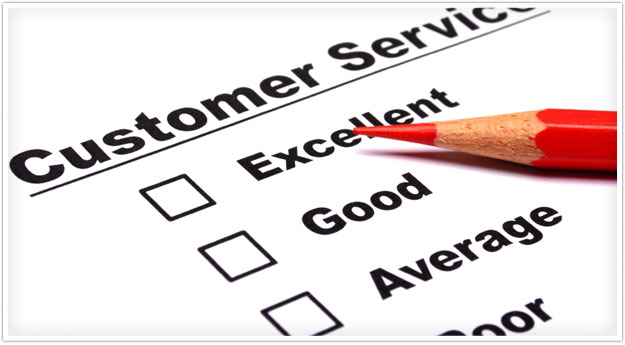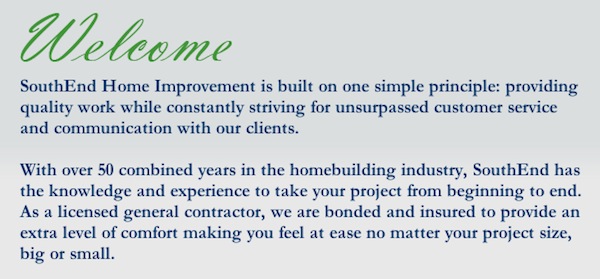Taming the Word of Mouth Monster

The customer's word is king.
In today’s culture of the Web, nothing holds greater sway than word of mouth. If want to grow your business, you need the help of your customers and fans.
Let’s look at an example:


The first clip is from SouthEnd Home Improvement's website; the second is a review that one of their customers posted on their Google Places page.
Both essentially say the same thing, speaking to the superior quality of the workmanship and customer service provided by the company. Yet Josh's review has probably motivated far more prospective clients to pick up the phone than the company's own site.
Why is this the case? After all, we don’t know Josh, and he hasn’t done anything to earn our trust.
However, we trust him implicitly because he is not affiliated with the company and thus (at least theoretically) not motivated by a sales agenda or self-interest.
Is it fair? Maybe not. But if you're going to compete successfully in today's consumer-driven marketplace, that's the reality you must live in. In this post-mass media era, you simply cannot talk frequently and loudly enough about your own products and services to muscle your way to the top.
Old marketing has been dethroned.
Marketing was a much simpler proposition back in the days when communication flowed in one direction from companies to customers.
You could buy exposure in the print, radio and TV media outlets of your choosing, and you could control the message down to the last detail. Your investment could be mapped out neatly on schedules and calendars, and you had access to all kinds of reassuring data like reach, frequency and cost per impression. Sign a contract, write a check, hand over your perfectly polished advertisements and wait for the phone to ring.
Traditional advertising is still there for the taking. The problem is that your customers aren’t buying into it anymore. There's simply too much information available to them from too many different channels. All the beautifully crafted ads your budget can buy can't save you if your Google Places page is littered with scathing reviews from dissatisfied customers.
Today's marketplace is ruled by the customer.
Companies today have inherited the burden of mistrust created by generations of brands before them that thrived on the shallow messages and misleading claims of traditional advertising.
Today's consumers view themselves as a band of brothers united behind the cause of holding companies accountable for providing quality products and services and making good on their promises. It's an "us against them" mentality, and you're on the wrong side of the fight until you prove otherwise.
You can't hide the truth from your customers any longer. A disgruntled customer 10 years ago was a mild annoyance. Customer service people could silence the complainer and wash their hands of the matter. It required a screw-up of much larger proportions for a company's bad practices to come to light in the traditional media.
However, one unhappy customer who voices their discontent on Facebook or Twitter has the power to cost you hundreds of potential sales. If something goes wrong and you're not pulling out all the stops to make things right, you're taking a big gamble with your brand's reputation.
In a consumer-driven marketplace, no brand is untouchable. No company is too big to be brought down by their customer.
Don't slay the dragon – make it your friend.
Word of mouth marketing is a fearful proposition for most businesses because it doesn't conform neatly to the metrics and regulations that drive the corporate world.
It's a lot like lightning in that there's no way to predict when and where it might strike. As such it's nearly impossible to capture on record and quantify. However, when it does touch down, there's no denying the power of it's impact.
So how do you harness this inherently anti-corporate force and put it to work for you in the real day-in, day-out, nitty-gritty world of business?
Treat every customer like Oprah.
While word of mouth is not a new concept by any stretch of the imagination, the advent of the digital age and social media have magnified its importance by putting a megaphone in the hands of every customer.
As a result, the customer service landscape is littered with potential PR landmines because you can't always tell who holds the biggest megaphone. Aggravate the wrong customer, and your reputation is toast.
Sure you can tell which members of your online community have the most Facebook friends or Twitter followers or blog subscribers. But things get messy when you encounter these people in the real world. They don't have their subscriber count tattooed on their forehead, and they don't introduce themselves with their Twitter handle.
So what do you do? You must treat every customer as though they have an Oprah-like ability to exert their influence.
Tread carefully, and make sure you demonstrate to each and every customer that you respect them and that their opinions matter. Maybe 99 out of 100 of them won't talk about you anyway, but you had better make sure that the one who speaks up is a happy camper.
Underpromise and overdeliver.
When you are in front of a prospect and you have the opportunity to make a sale, it's hard to force yourself to leave any cards on the table. You want to talk up every feature and every benefit in the most superlative degree.
However, if that's what it takes to close the deal, you'd better be prepared not only to make good on every claim but also to go above and beyond the call of duty.
Your sales pitch is your customer's baseline expectation. If you do only what you say, they'll thank you for a job well done and move on.
But if you go the extra mile and do more than promised, then you'll get them talking.
Never make a sale at the cost of your reputation.
You want to hear the cash register ring as much and as often as possible. However, selling your products to a customer when you know they're not actually a good fit for that person's specific needs is like playing Russian roulette.
If the product isn't really the right solution, your customer is going to be unhappy, and they're going to point the finger at you. They'll either assume that your product is subpar or, far worse, that your company is dishonest in its claims. That sale will end up costing your company and your brand's reputation dearly.
Make every impression count.
Generally speaking, your customers have short-term memories. Your relationship with them is only as good as your last encounter, and your brand’s reputation lives and dies in the moment of interaction.
Every phone call, every email, every visit to your store counts. That means you had better make sure that every person your customers come into contact with understands the importance of every touchpoint.
Customers are allowed to have bad days, to be unpleasant, even to be irrational. Customer service people are not.
Be remarkable – literally.
Your customers are not professional spokespeople. Promoting your company is not anywhere near the top of their agenda.
To get them talking about you, you must overcome the inertia of their natural tendency to talk about pretty much anything other than your company.
How can you do that? You must surprise and delight them. You must offer them something that's truly new, innovative and exciting. Your products or services must make their lives easier or better in ways that are meaningful and significant.
If you want buzz around your restaurant, you have to make it buzzworthy. Everything from the food to the service to the ambiance must offer something your customers can't get anywhere else in town.
Reinvent the wheel if you have to. When your customers find something so great that it ignites their passion, they won’t be able to keep it to themselves.
Feed them a steady diet of good content.
Your customers don't go through their lives talking up the products and services they use like they just stepped out of a commercial from the 1950s.
However, everyone loves a hot tip. Mary who enjoys working in her yard doesn't call up her girlfriend to have a heart-to-heart conversation about fertilizer. However, if she finds a great video on the Scotts website about how to keep her lawn lush and green all summer long, you'd better believe she'll email a link to the other members of her gardening club and retweet it for the benefit of the gardening enthusiasts who follow her.
With the simple act of sharing the video link, Mary's given Scotts her word of mouth endorsement as a trusted expert.
Content marketing works. Period.
Get the conversation started.
You can't control what your customers say about you. In fact, you can't force them to say anything about you at all. What you can do, however, is get the conversation started.
Social media has removed the communication barriers between you and your customers. Use that to your advantage by identifying the motivations that drive your fans to act and giving them ways to carry your torch that cater to their passions and personalities.
Ask for their input. Recognize their good ideas. Provide good information and inspiration that they'll want to pass along to their own networks. Get creative and make it fun to be your fan so they'll invite others to join the party.
No one ever said it would be easy.
Building good word-of-mouth marketing around your brand is a slow, arduous climb of earning the trust of your customers and motivating them to act on your behalf.
There are no shortcuts here. If you want good word of mouth, you must earn it the old-fashioned way through hard work and honest communication. You must deliver top quality products and services that provide exceptional value. You must develop authentic relationships with your customers and be attentive and responsive to their needs. If something goes wrong, you must go above and beyond to set things right. In all things, demonstrating genuine respect for your customers is paramount.
However, all of this hard work will not go unrewarded. The payoff for your investment of time and resources is getting and keeping the best kind of customers — true, dedicated fans that become advocates for your brand.
Thanks to the power of social media, when your evangelists start talking, they’re not just going to tell one person, they’re going to broadcast it to everyone in their social circles on the Web – via Facebook, Twitter, LinkedIn, their blog, etc. As a result, you’ll not only gain exposure to potential new customers, you’ll have an inherent foundation of trust by association.
The ripple effect that occurs as the good word of mouth around your brand continues to spread virally from one person’s network to another will do far more to sustain and propel the growth of your business in today’s economy than any form of paid advertisement that your money could buy.
Great authors are defined by their ability to set fire to the written word. All too often in today's digital information age, that creative spark is stifled, leaving the Web littered with content that is lifeless and ineffectual. Fame Foundry's Author has made it his mission to revive the act of writing as an art form, harnessing the power of language to command attention and ignite a following. It's the difference between telling a story and building a legend.